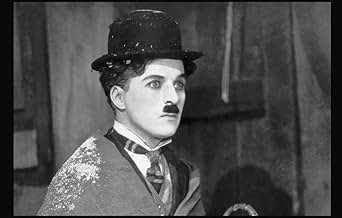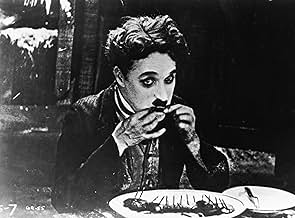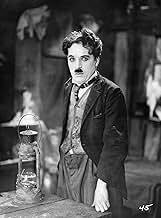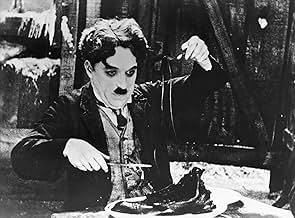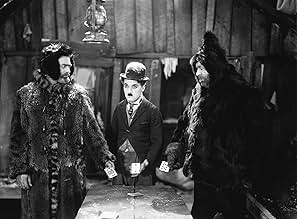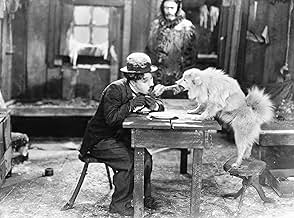- Candidato a 2 Oscar
- 7 vittorie e 3 candidature totali
Jack Adams
- Man in Dance Hall
- (non citato nei titoli originali)
Frank Aderias
- Eskimo Child
- (non citato nei titoli originali)
Leona Aderias
- Eskimo Child
- (non citato nei titoli originali)
Lillian Adrian
- Woman in Dance Hall
- (non citato nei titoli originali)
Sam Allen
- Man in Dance Hall
- (non citato nei titoli originali)
Claude Anderson
- Man in Dance Hall
- (non citato nei titoli originali)
Harry Arras
- Man in Dance Hall
- (non citato nei titoli originali)
Albert Austin
- Prospector
- (non citato nei titoli originali)
F.J. Beauregard
- Man in Dance Hall
- (non citato nei titoli originali)
Marta Belfort
- Woman in Dance Hall
- (non citato nei titoli originali)
William Bell
- Man in Dance Hall
- (non citato nei titoli originali)
Francis Bernhardt
- Man in Dance Hall
- (non citato nei titoli originali)
Riepilogo
Reviewers say 'The Gold Rush' is acclaimed for its comedy, visual storytelling, and iconic scenes. Charlie Chaplin's Little Tramp is lauded for humor and emotional depth. The film blends slapstick with themes of loneliness and resilience, resonating deeply. Its historical significance in silent cinema and influence on filmmakers are noted. The 1942 re-release with narration and music is appreciated, though some favor the original. It remains a timeless masterpiece.
Recensioni in evidenza
I've seen both version of this film--the original silent version from 1925 and the re-release by Chaplin in the 1940s. The difference is that the re-release was designed to appeal to a new audience that expected sound from their movies. To do this, title cards were removed--having Chaplin narrate the film. In addition, Chaplin-created music (for the most part--some were classical pieces), sound effects and singing were added to make the movie more palatable to the average viewer. I personally like BOTH versions and the one you watch is up to you if you get a copy of the Warner Brothers release on DVD--it has both plus excellent DVD extras. Otherwise, there have been a lot of public domain versions on video out there--many with terrible quality prints or music or both. The Warner version is the most pristine and beautiful silent print you can find. The version usually shown on Turner Classic movies is the 1942 re-release.
I use this film for my American history class when we do our unit on the history of film, though I might, in the future, use it for my Psychology classes as well (I teach both) because Chaplin's genius came from his obsessive-compulsive nature. The movie reportedly had 27 times more film exposed than you actually see in the film and the shoe eating segment was shot after more than 60 takes!!
The plot involves Charlie going to Alaska for the Gold Rush at the turn of the century. Along the way, he has a series of misadventures that have been thoroughly discussed in the other reviews here on IMDb. Suffice to say, the supporting acting was excellent and the story kept an excellent pace and had enough slapstick to make it fun to watch (something not true of all full-length slapstick comedies--sometimes, their pacing was negatively affected by the transition from shorts to full-length).
This is a gorgeous, well-executed piece of American art and a must for any real cinemaniac. The musical score (arranged by Chaplin), direction, acting and cinematography all are simply perfect--making this, in my opinion, the best full-length silent comedy ever made. This is saying a lot considering how much I love Harold Lloyd and Buster Keaton's films!
I use this film for my American history class when we do our unit on the history of film, though I might, in the future, use it for my Psychology classes as well (I teach both) because Chaplin's genius came from his obsessive-compulsive nature. The movie reportedly had 27 times more film exposed than you actually see in the film and the shoe eating segment was shot after more than 60 takes!!
The plot involves Charlie going to Alaska for the Gold Rush at the turn of the century. Along the way, he has a series of misadventures that have been thoroughly discussed in the other reviews here on IMDb. Suffice to say, the supporting acting was excellent and the story kept an excellent pace and had enough slapstick to make it fun to watch (something not true of all full-length slapstick comedies--sometimes, their pacing was negatively affected by the transition from shorts to full-length).
This is a gorgeous, well-executed piece of American art and a must for any real cinemaniac. The musical score (arranged by Chaplin), direction, acting and cinematography all are simply perfect--making this, in my opinion, the best full-length silent comedy ever made. This is saying a lot considering how much I love Harold Lloyd and Buster Keaton's films!
... in which Chaplin tried to modernize The Gold Rush by taking out the title cards, adding narration which he himself did, changing the music, and deleting some scenes. It isn't bad since Chaplin himself redid it, but I just prefer the original.
It isn't as funny as The Kid, not as heartbreaking as City Lights, and it doesn't have the social commentary of Modern Times. Instead it has a little bit of everything plus lots of atmosphere AND it takes Chaplin's Little Tramp out of some anonymous urban environment and lands him in a very specific place and time - the Klondike gold rush of the late 1890s. I could feel the biting cold, the hunger, the loneliness. And in spite of this being set in the 1890s and seeming quite authentic to its setting, this film has a very modern feel to it, almost timeless.
Chaplin's "little fellow" is introduced as a lone prospector. We never see him doing any prospecting, but it is later mentioned that he is not very successful at it and gives it up. The first part of the film has the little fellow waiting out a blizzard in a cabin with a wanted criminal in addition to a fellow prospector. The second part has Chaplin's character traveling to a Klondike boom town, watching a cabin for a more successful prospector, and falling in love with a dance hall girl who thinks his crush is just a big joke, at least at first.
I don't think it was Chaplin's best silent film, but it does manage to do all aspects of the production very well and I can see why some people would judge it as his best. And if that was Chaplin in that chicken suit, all I can say is that he had the motions of a chicken down pat. To know what I'm talking about, watch and find out.
It isn't as funny as The Kid, not as heartbreaking as City Lights, and it doesn't have the social commentary of Modern Times. Instead it has a little bit of everything plus lots of atmosphere AND it takes Chaplin's Little Tramp out of some anonymous urban environment and lands him in a very specific place and time - the Klondike gold rush of the late 1890s. I could feel the biting cold, the hunger, the loneliness. And in spite of this being set in the 1890s and seeming quite authentic to its setting, this film has a very modern feel to it, almost timeless.
Chaplin's "little fellow" is introduced as a lone prospector. We never see him doing any prospecting, but it is later mentioned that he is not very successful at it and gives it up. The first part of the film has the little fellow waiting out a blizzard in a cabin with a wanted criminal in addition to a fellow prospector. The second part has Chaplin's character traveling to a Klondike boom town, watching a cabin for a more successful prospector, and falling in love with a dance hall girl who thinks his crush is just a big joke, at least at first.
I don't think it was Chaplin's best silent film, but it does manage to do all aspects of the production very well and I can see why some people would judge it as his best. And if that was Chaplin in that chicken suit, all I can say is that he had the motions of a chicken down pat. To know what I'm talking about, watch and find out.
One of the great Chaplin movies is 'The Gold Rush' and although it is not his best it contains one of the best known Chaplin-sequences. The sequence with the dancing rolls is one of the best I have seen in any Chaplin, whether it is a feature film or a two-reeler. For me this alone makes 'The Gold Rush' worth watching.
There are other great moments in this story where Chaplin is the Lone Prospector who falls in love with a girl named Georgia (Georgia Hale). When Chaplin has to find some gold (the movie isn't name 'The Gold Rush' for nothing) together with Hank (Henry Bergman) they stay in a cottage in the mountains. The sequence with this cottage after a blizzard is another that belongs to the greatest sequences in a Chaplin movie.
Of course we know from the start how things will end with the girl and the gold but the way that leads to that point is a nice one. Personally I think it is not great all the time, some sequences make it great, and sometimes even a little too simple. Because of the sequences described above (and some others) and because of the artist that Chaplin is this still belongs to the better silent movies I have seen.
There are other great moments in this story where Chaplin is the Lone Prospector who falls in love with a girl named Georgia (Georgia Hale). When Chaplin has to find some gold (the movie isn't name 'The Gold Rush' for nothing) together with Hank (Henry Bergman) they stay in a cottage in the mountains. The sequence with this cottage after a blizzard is another that belongs to the greatest sequences in a Chaplin movie.
Of course we know from the start how things will end with the girl and the gold but the way that leads to that point is a nice one. Personally I think it is not great all the time, some sequences make it great, and sometimes even a little too simple. Because of the sequences described above (and some others) and because of the artist that Chaplin is this still belongs to the better silent movies I have seen.
The Gold Rush is one of Chaplin's best films, as well as one of his most famous. It has been said that it is the film that he most wanted to be remembered by, and it's not hard to see why. Chaplin plays the part of the lone prospector, a young miner during the gold rush. After getting caught in a storm, he hurries to the only shelter that he can find, a wood cabin in the middle of the storm. It turns out that it is already inhabited, and by a tough criminal named Black Larson, no less, and the scene in which Charlie and Big Jim, another prospector, insist to Black Larson that they are going to stay is one of the countless memorable scenes in the film.
Charlie and Big Jim are left alone and without food when Larson goes off to face the storm looking for food (having drawn the lowest card in another amusing scene), and the scenes in the cabin are some of the best in the entire film. There is, of course, the boot eating scene, memorable not only because of its cleverness and effectiveness, but also because while making the film, Chaplin ate so much boot (which was made out of licorice) before he was satisfied with the take that he had to be taken to the hospital to have his stomach pumped. Another thing that was really well done was the special effects. I am still amazed every time I watch the film at how realistic it looks when there is a long shot from outside showing Charlie hanging from the door of the cabin, which is balanced precariously on the edge of a cliff. Also notice the fast paced and very effective music during this scene, the same song that is played in the best scene of the 1996 film Shine, with Geoffrey Rush.
There is also a very noteworthy love element of The Gold Rush, a part of the story that Chaplin generally has much success with in his films. Charlie's amorous interests in Georgia, a dance hall girl, leads to the scene where he performs the famous dance of the dinner rolls, probably the most famous scene in the film, which was also performed very well by Johnny Depp in Benny & Joon. Charlie's relationship with Georgia is also the thing that leads to his presentation of his sympathy for the lower classes, when he meets her on the ship after having become a multi-millionaire. Chaplin's full length films are inherently more famous than his earlier short comedies, and The Gold Rush is one of the best of his full length features. A must see for any Chaplin fan, but The Gold Rush is also a film that anyone who is interested in quality comedy should watch.
Charlie and Big Jim are left alone and without food when Larson goes off to face the storm looking for food (having drawn the lowest card in another amusing scene), and the scenes in the cabin are some of the best in the entire film. There is, of course, the boot eating scene, memorable not only because of its cleverness and effectiveness, but also because while making the film, Chaplin ate so much boot (which was made out of licorice) before he was satisfied with the take that he had to be taken to the hospital to have his stomach pumped. Another thing that was really well done was the special effects. I am still amazed every time I watch the film at how realistic it looks when there is a long shot from outside showing Charlie hanging from the door of the cabin, which is balanced precariously on the edge of a cliff. Also notice the fast paced and very effective music during this scene, the same song that is played in the best scene of the 1996 film Shine, with Geoffrey Rush.
There is also a very noteworthy love element of The Gold Rush, a part of the story that Chaplin generally has much success with in his films. Charlie's amorous interests in Georgia, a dance hall girl, leads to the scene where he performs the famous dance of the dinner rolls, probably the most famous scene in the film, which was also performed very well by Johnny Depp in Benny & Joon. Charlie's relationship with Georgia is also the thing that leads to his presentation of his sympathy for the lower classes, when he meets her on the ship after having become a multi-millionaire. Chaplin's full length films are inherently more famous than his earlier short comedies, and The Gold Rush is one of the best of his full length features. A must see for any Chaplin fan, but The Gold Rush is also a film that anyone who is interested in quality comedy should watch.
Charlie Chaplin is the Lone Prospector who goes to Klondike, Alaska in search of gold.There he meets and falls in love to beautiful Georgia (Georgia Hale).In cold and snowy Alaska he rambles forward looking for gold with his fellow prospector Big Jim McKay (Mack Swain) thinking of her.A genius called Charlie Chaplin made in 1925 this silent movie masterpiece known as The Gold Rush.Now nearly 80 years after the film was made we get to watch this genius in a tramp suit doing his job.And he did it well.Better than probably anybody.He could make us laugh and he could make us cry.Maybe even both of those at the same time.Chaplin realized that every good comedy has a little tragedy. Of course I have to give credits to other actors as well.Mack Swain as Big Jim McKay is not only a big man, he's also big at his acting skills. Georgia Hale is as beautiful of woman as she is a great actress. The Gold Rush is filled with marvelous scenes.The most memorable is the shoe-eating scene.Chaplin on the dance floor is also something to remember.Through the movie you can hear the score Chaplin composed to this movie.It works perfectly.Just like the whole movie.It's pure gold from the beginning till the end.
Lo sapevi?
- QuizSir Charles Chaplin stated that this was the film by which he most wanted to be remembered.
- BlooperWhen Big Jim is delirious and thinks The Lone Prospector is a chicken, The Lone Prospector removes a knife from the table and hides it in the bed. In one of the next shots, the knife is back on the table. Then in the next shot, it is gone again.
- Versioni alternativeThere is a 1942 re-issue version, prepared by Charles Chaplin himself, which uses his own narration, music score, and editing (running time: 72 minutes). This version is the only one which has its copyright owned by the Chaplin Film company. Many scenes of the 1942 version derived from an alternate camera that was shooting simultaneously. This explains some of the very slight differences in camera angle, although Chaplin also deleted some footage in order to tighten the pacing (such as Big Jim and the Tramp's near-encounter in the Gold Rush town and the shot of a woman comforting another woman during the singing of "Auld Lang Syne".
- ConnessioniEdited into Werner Herzog Eats His Shoe (1980)
I più visti
Accedi per valutare e creare un elenco di titoli salvati per ottenere consigli personalizzati
- How long is The Gold Rush?Powered by Alexa
Dettagli
- Data di uscita
- Paese di origine
- Siti ufficiali
- Lingue
- Celebre anche come
- The Gold Rush
- Luoghi delle riprese
- Azienda produttrice
- Vedi altri crediti dell’azienda su IMDbPro
Botteghino
- Budget
- 923.000 USD (previsto)
- Lordo in tutto il mondo
- 36.273 USD
- Tempo di esecuzione1 ora 35 minuti
- Colore
- Mix di suoni
- Silent(original release)
- Proporzioni
- 1.33 : 1
Contribuisci a questa pagina
Suggerisci una modifica o aggiungi i contenuti mancanti



